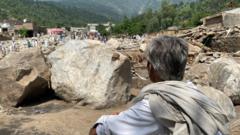As the monsoon season takes a grim toll on Pakistan, this natural disaster highlights the growing vulnerability caused by climate change, which is exacerbating the risks of such catastrophic events.
Recent events have brought devastation to the lush landscapes of northern Pakistan. On the morning of August 15, residents of Bishnoi awoke to a serene Sunday, only to be unprepared for the sudden ravaging floods that followed. Witnesses report that a violent torrent swept through the village, carrying massive rocks and obliterating buildings, transforming the picturesque community into a scene of despair.
As local Israr Khan recounted, "The entire village was crushed." Rescue workers and desperate locals are now digging through piles of debris using shovels and bare hands in hopes of recovering the missing. The Provincial Disaster Management Authority (PDMA) reports that Buner district has suffered the most devastating impacts, with 217 fatalities attributed to the floods, and the outlook is grim.
Throughout the province, an estimated 50% of homes are completely uninhabitable, and many celebrations quickly turned into tragedies, particularly in households preparing for weddings. As the death toll rises, it is clear that entire communities are in mourning.
This monsoon season has been particularly severe. The National Disaster Management Agency documents that at least 507 individuals have lost their lives in flood-related incidents since the rains began in late June. The glacial regions of Khyber Pakhtunkhwa have been hit especially hard by the impacts of climate change. With glaciers retreating rapidly, the risk of flash floods and landslides is heightened as rocks and soil dislodge more easily.
Heavy rainfall is projected to continue until August 21, urging local governments to declare several areas as disaster zones. Flash floods and landslides put additional pressure on already strained response efforts in these mountainous regions, where timely evacuations are crucial.
In the neighboring Swat Valley, one school principal's foresight saved hundreds of lives when he ordered an evacuation just moments before rising waters swept through. However, not every community has been as fortunate, as many residents recount harrowing tales of loss. Abdul Salam recalls how he lost his entire family in the floods and could not connect with them as he desperately tried to reach them.
While efforts to coordinate relief and rescue operations continue, the level of destruction is evident as agricultural lands lie flattened and homes are washed away. In Bishnoi, relief efforts by organizations like Al-Khidmat are underway, distributing essential goods and setting up medical camps.
As communities converge to assist each other, it is a painful reminder of the fragility of safety amidst nature’s fury. Bodies are still being recovered, but many families face an uncertain future with no homes and, tragically, no loved ones. The search for those still missing is a somber endeavor, with hopes dwindling as volunteers work tirelessly to bring closure to the bereaved.
Recent events have brought devastation to the lush landscapes of northern Pakistan. On the morning of August 15, residents of Bishnoi awoke to a serene Sunday, only to be unprepared for the sudden ravaging floods that followed. Witnesses report that a violent torrent swept through the village, carrying massive rocks and obliterating buildings, transforming the picturesque community into a scene of despair.
As local Israr Khan recounted, "The entire village was crushed." Rescue workers and desperate locals are now digging through piles of debris using shovels and bare hands in hopes of recovering the missing. The Provincial Disaster Management Authority (PDMA) reports that Buner district has suffered the most devastating impacts, with 217 fatalities attributed to the floods, and the outlook is grim.
Throughout the province, an estimated 50% of homes are completely uninhabitable, and many celebrations quickly turned into tragedies, particularly in households preparing for weddings. As the death toll rises, it is clear that entire communities are in mourning.
This monsoon season has been particularly severe. The National Disaster Management Agency documents that at least 507 individuals have lost their lives in flood-related incidents since the rains began in late June. The glacial regions of Khyber Pakhtunkhwa have been hit especially hard by the impacts of climate change. With glaciers retreating rapidly, the risk of flash floods and landslides is heightened as rocks and soil dislodge more easily.
Heavy rainfall is projected to continue until August 21, urging local governments to declare several areas as disaster zones. Flash floods and landslides put additional pressure on already strained response efforts in these mountainous regions, where timely evacuations are crucial.
In the neighboring Swat Valley, one school principal's foresight saved hundreds of lives when he ordered an evacuation just moments before rising waters swept through. However, not every community has been as fortunate, as many residents recount harrowing tales of loss. Abdul Salam recalls how he lost his entire family in the floods and could not connect with them as he desperately tried to reach them.
While efforts to coordinate relief and rescue operations continue, the level of destruction is evident as agricultural lands lie flattened and homes are washed away. In Bishnoi, relief efforts by organizations like Al-Khidmat are underway, distributing essential goods and setting up medical camps.
As communities converge to assist each other, it is a painful reminder of the fragility of safety amidst nature’s fury. Bodies are still being recovered, but many families face an uncertain future with no homes and, tragically, no loved ones. The search for those still missing is a somber endeavor, with hopes dwindling as volunteers work tirelessly to bring closure to the bereaved.




















